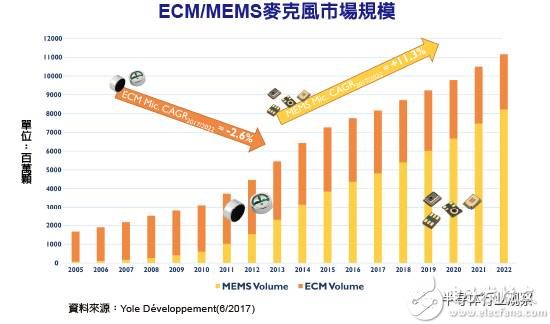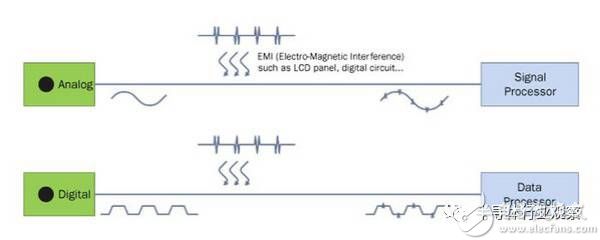The intelligent voice assistant has become a popular fried chicken. As a sound sensor that is indispensable for related applications, the market size of the microphone will also explode significantly, and the MEMS microphone will benefit the most. As for the electret microphone (ECM), although it has the advantage of high signal-to-noise ratio (SNR), because the matching work is relatively cumbersome, it is not the most ideal choice for intelligent voice assistant applications that require an array architecture.
Research firm Yole predicts that shipments of MEMS microphones will grow steadily with the surge in demand for applications such as smart voice assistants and vehicles. By 2022, annual shipments are expected to exceed 8 billion; ECM microphones The volume of goods is slowly shrinking. By 2022, shipments will be only about 3 billion. In such a huge market, we need to pay attention to the technology of this product.

Overview of the structure and working mode of MEMS microphones
The MEMS microphone includes a movable diaphragm and a static backplane fabricated on a common wafer substrate using common deposition and selective etching processes. The backing plate has perforations that allow air to circulate without causing deviations. The diaphragm is designed to accommodate changes in air pressure caused by sound waves. Bending causes the diaphragm to move relative to the backplate, producing a proportional change in capacitance. A companion IC packaged with the MEMS transducer converts this change in capacitance into an electrical signal in either analog or digital form.
There are MEMS microphones with analog or digital outputs on the market. Analog microphones basically consist of MEMS transducers and companion analog amplifier integrated circuits (ICs), a popular solution for small handheld devices, such as feature phones and entry-level to mid-range smartphones.
Digitizing
Digital microphones that integrate analog adjustment signals and analog-to-digital converters (ADCs) are often the device of choice for PCs or high-end smartphones. Digital technology utilizes inherently higher RF and immunity to electromagnetic interference (EMI) for better audio performance, as shown in Figure 1. In addition, the circuit design and board layout can be simplified, making it easier to change the design without modifying the resistor and capacitor values.

Figure 1: Digital improvement of noise immunity
Most digital microphones also have a clock and an L/R control input. The clock input is used to control the Δ? modulator to convert the analog signal of the sensor into a digital pulse density modulation (PDM) signal. Typical clock frequencies range from 1MHz to 3.5 MHz. The output of the microphone is driven to the appropriate level of the selected clock edge and then enters the other half of the clock period of a high impedance state. This allows two digital microphone outputs to share a single data line (Figure 2). The L / R input determines the clock edge of valid data.

Figure 2: Digital microphones reduce the number of transmission lines
Digital MEMS microphones offer high noise immunity and simplified circuit design for multi-microphone arrays to eliminate echo and noise, as well as beamforming for directional sensitivity. A common way for smartphones to eliminate noise is to place one or more additional microphones away from the main voice microphone, such as on the edge or back of the case, detecting noise from the surrounding environment, and then from the voice microphone. Subtracting the output can improve the quality of the call. Noise canceling microphones are also often used in video recording mode.
Beamforming also uses two or more microphone arrays. While most microphones have omnidirectional sensitivity, some applications can benefit from increased sensitivity in a particular direction or reduced sensitivity in other directions, such as improved audio quality and clarity during a conference call or during a call. Beamforming can utilize digital algorithms to the microphone output of the array based on the phase difference of the sounds coming from different directions, and can also determine the direction in which a particular sound is coming.
About the main technical characteristics of the microphone
1. Sensitivity
Sensitivity is an important indicator of the efficiency of microphone acoustic-electric conversion. It represents the open-circuit output voltage measured in a free sound field with a microphone frequency at a constant sound pressure of 1 KHz and a positive sound source (ie, an acoustic incident angle of zero). The unit is millivolts per kPa. 1Pa=10bar1ubar is roughly equivalent to the normal speaking volume of a person, and the sound pressure measured at a distance of 1 m.
The dynamic microphone has a sensitivity of about 1.5 to 4 mV/Pa, while the condenser microphone has a sensitivity about 10 times higher than the moving coil, about 20 mV/Pa.
The sensitivity of the microphone is also expressed in decibels (db), which is 1 volt and 0 db. Since the sensitivity is much smaller than 1 volt/pascal, the sensitivity is expressed as one db.
High sensitivity of the microphone is a good thing. It can provide a higher input level to the mixer, which can improve the signal-to-noise ratio, but it is too high and its output voltage is high, which is prone to excessive distortion.
When used for karaoke singing, the distance between the microphone and the mouth is very close, so the sensitivity requirement is not high. If used for band recordings or stage performances, the sensitivity requirements are higher.
2. Frequency response
The frequency response is an important indicator of the frequency distortion during the microphone's electrical conversion process. Under the action of constant sound pressure and specified incident angle acoustic wave, the ratio of the open output voltage of each frequency acoustic wave signal to the open frequency output voltage of the specified frequency microphone is called the frequency response of the microphone and is expressed in decibels (db). The general professional microphone frequency response curve tolerance range is 2db. The frequency response is that when the microphone receives sounds of different frequencies, the output signal will amplify or attenuate as the frequency changes. The ideal frequency response curve is a horizontal line, which represents the characteristic that the output signal can directly represent the original sound, but this ideal situation is not easy to implement.
In the frequency response graph, the horizontal axis is the frequency in Hertz (Hz). Most of the cases are represented by logarithms; the vertical axis is the intensity of the sound, and the unit is decibel (db). 0 dB means that the output signal of the microphone is consistent with the original sound and has not been changed; greater than 0 dB means the output signal is amplified; less than 0 dB means the output signal is attenuated.
Different microphones are used, and the range of frequency response and unevenness are different.
Dynamic microphones often do not take a flat frequency response curve, but slightly increase in the high frequency band (3 ~ 5KHz), which can increase the brightness and clarity of the pickup. Generally, when it is used at a very close distance from the sound source, the phenomenon of low frequency rise will be called "near talk effect", so it is better to have a significant attenuation in the low frequency band below 150 Hz.
The frequency response curve of a condenser microphone is flatter than that of a moving coil, and the reduction is more realistic. Common microphone frequency response curves are mostly high and low frequency attenuation, while medium and high frequency are slightly amplified; low frequency attenuation can reduce the interference of low frequency noise around the recording environment.
3. Pointing feature
The characteristic that the sensitivity of the microphone changes with the direction of incidence of the sound wave is called directivity. Commonly used to point to the graph to represent. When picking up sounds with microphones with different pointing characteristics, the ratio of direct sound/reverberation sound is greatly affected. We can choose the right directional microphone based on the sound source.
Common directivity is omnidirectional (no pointing), heart shape, super heart type, sharp type, 8-shaped type (two-way) and so on.
a. No pointing: This feature has the same sensitivity for incident sound waves in all directions. When picking up the ambient sound, an omnidirectional microphone is usually used, so that the picked-up sound has a strong spatial sense, but it is not suitable for use in environments with high noise.
b. Heart shape: This characteristic is effective for the incident of the sound wave in the 180-degree direction on the front side, and the back sound is suppressed. The front side sensitivity is larger and the side is smaller and the back side is smaller. A heart-shaped directional microphone is ideal if you want to pick up the sound source directly in front.
c. Sharp type: This feature has a positive 110 degree angle of incidence and suppresses sound feedback better.
d. Supercardioid (unidirectional microphone): This feature has the same effect as the 90 degree incident angle on the back side. Its directivity is sharper than that of a cardioid microphone, its front sensitivity is extremely high, and its sensitivity is sharply attenuated in other directions. It is especially suitable for high-noise environments and stereo pickup.
4, the output impedance:
The impedance of the microphone itself seen from both ends of the lead of the microphone is called the output impedance. Currently common microphones have high impedance and low impedance. The high-impedance value is about 1000~20000 ohms, which can be directly connected to the amplifier; the low-impedance type is 50-1000 ohms, which can be connected to the amplifier after being matched by the transformer. The output voltage of the high group is slightly higher, but the bypass function of the lead capacitor is larger, which causes the high frequency to drop, and is also susceptible to external electromagnetic field interference. Therefore, the microphone lead should not be too long, generally 10 to 20 meters. should. The low-impedance output does not have this defect, so the noise level is low, the microphone leads can be lengthened accordingly, and some low-impedance microphone leads with a loudspeaker can reach 100 meters. If the distance is longer, a preamp should be added.
5. Dynamic Range
It refers to the difference between the small output of the microphone and the large undistorted signal. The small dynamic range causes distortion of the sound and deteriorates the sound quality, so a large dynamic range is required.
6. Signal to noise ratio
Refers to the ratio of the output signal voltage at the specified input voltage to the residual noise voltage output when the input voltage is cut off. It can also be regarded as the ratio between the intensity of the large undistorted sound signal and the noise intensity emitted at the same time, usually S /N means that it is generally in decibels (dB). The higher the signal-to-noise ratio is, the higher the signal-to-noise ratio is. The less the clutter is mixed in the signal, the higher the quality of the reduction.
7. Large input sound pressure level
The larger input sound pressure level is a measure of the large sound pressure level that the microphone can withstand up to 0.5 total harmonic distortion, typically expressed in decibels (dB).
No matter what type of microphone, the nonlinear distortion of the sound-electrical conversion will increase with the increase of the sound pressure level, so each microphone has a "higher applicable sound pressure level" limit. When the sound pressure level of the microphone exceeds this limit, the nonlinear distortion of the electrical signal output by the microphone will exceed its allowable level, and the subsequent electro-acoustic equipment cannot be corrected. Therefore, the microphone used must meet the sound pressure level at the pickup point.
The larger input sound pressure level of a professional microphone is generally set higher, and as long as it is properly spaced from the sound source, no audible distortion is produced.
8. Voice
The technical parameters of the microphone play a good reference for us to use the microphone according to different purposes or requirements, but not, especially the tone of the microphone cannot be standardized by technical parameters, and the tone depends more on the harmonics of the sound. There are many factors affecting harmonics. Environment, singer, and sound reinforcement recording equipment are the most important. Even a microphone stand, a curtain, or a small screw will affect the tone.
24V Battery Pack ,Large Battery Pack,24 V Battery Pack,24V Lithium Ion Battery Pack
Zhejiang Casnovo Materials Co., Ltd. , https://www.casnovo-new-energy.com